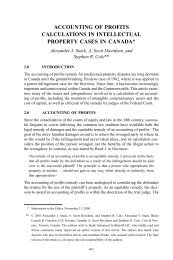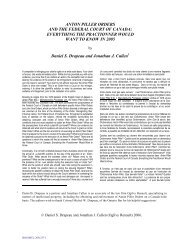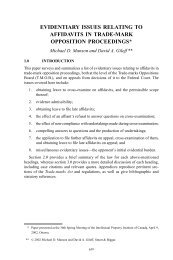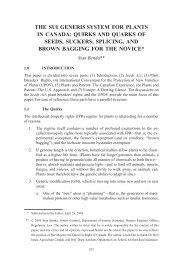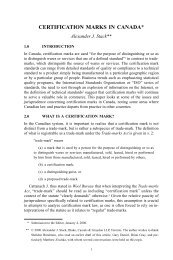A Comparative Overview of Canadian, US and European ...
A Comparative Overview of Canadian, US and European ...
A Comparative Overview of Canadian, US and European ...
Create successful ePaper yourself
Turn your PDF publications into a flip-book with our unique Google optimized e-Paper software.
Double patenting An applicant is only entitled to a single<br />
patent on an invention. Double patenting<br />
refers to an applicant having two<br />
patents/applications having claims with<br />
identical scope (co-terminous double<br />
patenting) or that are not patentably<br />
distinct (obviousness type double<br />
patenting). The result is the impermissible<br />
extension <strong>of</strong> patent term beyond the 20<br />
year term allowed for a single patent filing.<br />
Consequently, one <strong>of</strong> the filings would be<br />
objected to in prosecution because <strong>of</strong> the<br />
other, or if both were to be issued as<br />
patents, this could be used as grounds to<br />
challenge their validity. A patentee cannot<br />
disclaim the extra period <strong>of</strong> protection to<br />
rescue the later expiring filing from<br />
invalidity.<br />
A Terminal Disclaimer may be filed in response<br />
to an obviousness type double patenting<br />
objection. This means that the applicant would<br />
disclaim rights in the later expiring patent, so that<br />
the statutory 20 year term <strong>of</strong> protection would<br />
not be exceeded <strong>and</strong> both filings could be<br />
allowed to issue as valid patents.<br />
This provides a straightforward manner to deal<br />
with double patenting objections <strong>and</strong> reduces the<br />
risk <strong>of</strong> patent invalidity based on allegation <strong>of</strong><br />
double patenting.<br />
Unlike in Canada <strong>and</strong> <strong>US</strong>, where double<br />
patenting objections are commonly raised<br />
during prosecution <strong>and</strong> are frequently a<br />
basis for challenging the validity <strong>of</strong> granted<br />
patents, double patenting has very limited<br />
application under <strong>European</strong> patent<br />
practice <strong>and</strong> double patenting is not a<br />
basis to oppose a patent in <strong>European</strong><br />
opposition proceedings.<br />
This is a brief <strong>and</strong> very simplified summary <strong>of</strong> selected aspects <strong>of</strong> the three patent systems. It is intended for general informational purposes <strong>and</strong> should not be<br />
used as a basis for taking decisions with regards to any specific cases. Qualified advice should be sought regarding any specific fact situations. All references<br />
WSLegal\049190\00037\8068137v1<br />
to CETA are based on our underst<strong>and</strong>ing <strong>of</strong> the provisions <strong>of</strong> CETA, as determined from sources available on the Internet. IPIC ©2012<br />
17/24



